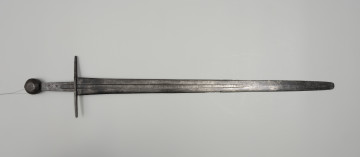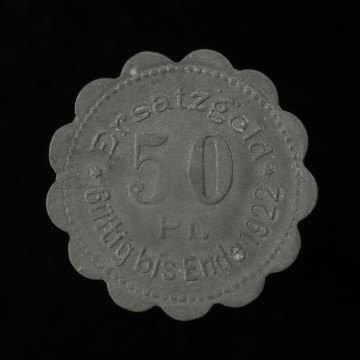
Type XII one-handed sword (Oakeshott)
1250 — 1325
National Museum in Szczecin
Part of the collection: Militaria
At the beginning of the 14th century, the production of longswords, also called two-handed swords due to the way they are handled, began in Europe, and the featured weapon is one of them. The sword has a narrow blade with a ridge with a so-called diamond-shaped cross-section, which made it possible to inflict thrusts, aiming between the crevices of armour. It is characterised by an extended handle grip with a forging spot showing, given the lack of binding. It is difficult to say whether this was a later elongation or whether it occurred during the manufacture time of the weapon. This gave the sword a different blade-to-tang ratio, also found in items from the collections of the Historiska Museet in Stockholm (inv. No. 27706/1965) or Stralsund Museum (inv. no. 2086). The latter came from the pre-war collection of the Szczecin Stadt Museum. The Stockholm sword is dated after 1400, while the other is dated to the late 15th century. Both had corresponding goblet-shaped pommels and curved towards the central ridge, and quillons flattened and widening at the ends with three or four holes. The cross-guard of the Szczecin object is different from those, being slightly curved upwards with curled ends. The pommel resembles a cup shape, but its lower part is shorter. Remains of two engraved marks filled with yellow metal are preserved on the blade of the sword. One of them, consisting of elongated irregular lines, reads as the mark of a wolf. It was initially adopted in Passau, and subsequently in the 14th and 15th centuries swords were marked in this manner in other sword-making centres, including Solingen, Augsburg and Nuremberg. Furthermore, a rosette-shaped smith's stamp, interpreted as a star, was embossed on the tang. Justyna Bądkowska
Author / creator
Object type
two-handed sword, longsword
Technique
forging, fine detail finishing
Material
iron, copper
Origin / acquisition method
acquisition
Creation time / dating
Creation / finding place
Owner
Muzeum Narodowe w Szczecinie
Identification number
Location / status

1250 — 1325
National Museum in Szczecin

1920
National Museum in Szczecin

circa 1590 — 1610
National Museum in Szczecin
DISCOVER this TOPIC
Museum of King Jan III's Palace at Wilanów
DISCOVER this PATH
Educational path